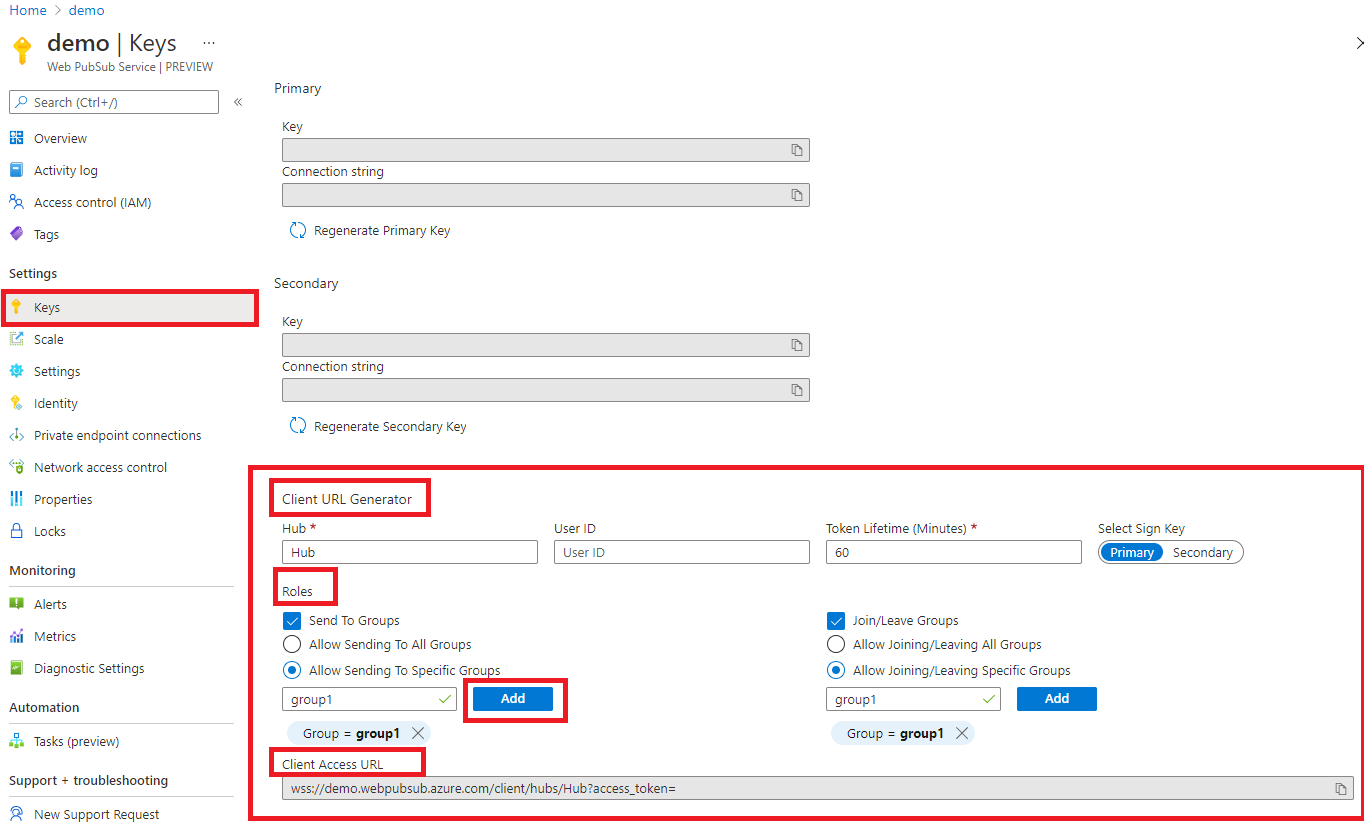Note
Access to this page requires authorization. You can try signing in or changing directories.
Access to this page requires authorization. You can try changing directories.
Note
Details about the terms used here are described in key concepts article.
The client-side SDK aims to speed up developer's workflow; more specifically,
- simplifies managing client connections
- simplifies sending messages among clients
- automatically retries after unintended drops of client connection
- reliably deliveries messages in number and in order after recovering from connection drops
As shown in the diagram, your clients establish WebSocket connections with your Web PubSub resource.

Important
Raw connection strings appear in this article for demonstration purposes only.
A connection string includes the authorization information required for your application to access Azure Web PubSub service. The access key inside the connection string is similar to a root password for your service. In production environments, always protect your access keys. Use Azure Key Vault to manage and rotate your keys securely and secure your connection with WebPubSubServiceClient.
Avoid distributing access keys to other users, hard-coding them, or saving them anywhere in plain text that is accessible to others. Rotate your keys if you believe they may have been compromised.
Getting started
Prerequisites
- Java Development Kit (JDK) with version 8 or above
- Azure subscription
- An existing Web PubSub instance
Adding the package to your product
<dependency>
<groupId>com.azure</groupId>
<artifactId>azure-messaging-webpubsub-client</artifactId>
<version>1.0.0-beta.1</version>
</dependency>
Authenticate the client
A client uses a Client Access URL to connect and authenticate with the service. The URL follows a pattern of wss://<service_name>.webpubsub.azure.com/client/hubs/<hub_name>?access_token=<token>. There are multiple ways to get a Client Access URL. As a quick start, you can copy and paste from Azure portal, and for production, you usually need a negotiation server to generate the URL. See details.
Use Client Access URL from Azure portal
As a quick start, you can go to Azure portal and copy the Client Access URL from Keys blade.

As shown in the diagram, the client is granted permission of sending messages to specific groups and joining specific groups. Learn more about client permission, see permissions.
WebPubSubClient client = new WebPubSubClientBuilder()
.clientAccessUrl("<client-access-url>")
.buildClient();
Use negotiation server to generate Client Access URL
In production, a client usually fetches the Client Access URL from a negotiation server. The server holds the connection string and generates the Client Access URL through WebPubSubServiceClient. As a sample, the code snippet just demonstrates how to generate the Client Access URL inside a single process.
Raw connection strings appear in this article for demonstration purposes only. In production environments, always protect your access keys. Use Azure Key Vault to manage and rotate your keys securely and secure your connection with WebPubSubServiceClient.
// WebPubSubServiceAsyncClient is from com.azure:azure-messaging-webpubsub
// create WebPubSub service client
WebPubSubServiceAsyncClient serverClient = new WebPubSubServiceClientBuilder()
.connectionString("<connection-string>")
.hub("<hub>>")
.buildAsyncClient();
// wrap WebPubSubServiceAsyncClient.getClientAccessToken as WebPubSubClientCredential
WebPubSubClientCredential clientCredential = new WebPubSubClientCredential(Mono.defer(() ->
serverClient.getClientAccessToken(new GetClientAccessTokenOptions()
.setUserId("<user-name>")
.addRole("webpubsub.joinLeaveGroup")
.addRole("webpubsub.sendToGroup"))
.map(WebPubSubClientAccessToken::getUrl)));
// create WebPubSub client
WebPubSubClient client = new WebPubSubClientBuilder()
.credential(clientCredential)
.buildClient();
Features to differentiate WebPubSubClient and WebPubSubServiceClient.
| Class Name | WebPubSubClient | WebPubSubServiceClient |
|---|---|---|
| Package Name | azure-messaging-webpubsub-client | azure-messaging-webpubsub |
| Features | Used on client side. Publish messages and subscribe to messages. | Used on server side. Generate Client Access URL and manage clients. |
Examples
Consume messages from the server and groups
A client can add callbacks to consume messages from the server and groups. Note, clients can only receive group messages that it has joined.
client.addOnGroupMessageEventHandler(event -> {
System.out.println("Received group message from " + event.getFromUserId() + ": "
+ event.getData().toString());
});
client.addOnServerMessageEventHandler(event -> {
System.out.println("Received server message: "
+ event.getData().toString());
});
Add callbacks for connected, disconnected, and stopped events
When a client connection is connected to the service, the connected event is triggered.
When a client connection is disconnected and fails to recover, the disconnected event is triggered.
When a client is stopped, which means the client connection is disconnected and the client stops trying to reconnect, the stopped event is triggered. This usually happens after the client.StopAsync() is called, or disabled AutoReconnect. If you want to restart the client, you can call client.StartAsync() in the Stopped event.
client.addOnConnectedEventHandler(event -> {
System.out.println("Connection is connected: " + event.getConnectionId());
});
client.addOnDisconnectedEventHandler(event -> {
System.out.println("Connection is disconnected");
});
client.addOnStoppedEventHandler(event -> {
System.out.println("Client is stopped");
});
Operation and retry
By default, the operation such as client.joinGroup(), client.leaveGroup(), client.sendToGroup(), client.sendEvent() has three reties. You can use WebPubSubClientBuilder.retryOptions() to change. If all retries have failed, an error is thrown. You can keep retrying by passing in the same ackId as previous retries, thus the service can help to deduplicate the operation with the same ackId.
try {
client.joinGroup("testGroup");
} catch (SendMessageFailedException e) {
if (e.getAckId() != null) {
client.joinGroup("testGroup", e.getAckId());
}
}
Troubleshooting
Enable logs
You can set the following environment variable to get the debug logs when using this library.
export AZURE_LOG_LEVEL=verbose
For more detailed instructions on how to enable logs, you can look at the @azure/logger package docs.
Live Trace
Use Live Trace tool from Azure portal to inspect live message traffic through your Web PubSub resource.